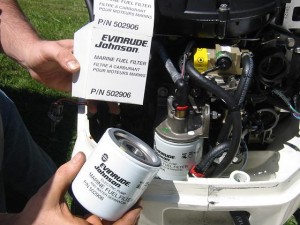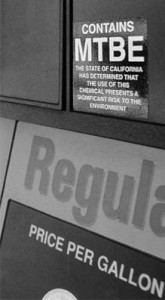Fuel Tanks Beware: The Ethanol Issue
 As many boaters know, the Environmental Protection Agency has been cracking down of production of inefficient vehicles in recent years – whether they are designed to drive along roads or motor through a waterway. In some respects, the influx of restrictions and guidelines has been a good thing. After all, most boaters want to make as little lasting environmental impact as possible as they go about their hobby.
As many boaters know, the Environmental Protection Agency has been cracking down of production of inefficient vehicles in recent years – whether they are designed to drive along roads or motor through a waterway. In some respects, the influx of restrictions and guidelines has been a good thing. After all, most boaters want to make as little lasting environmental impact as possible as they go about their hobby.
Unfortunately, all this eco-awareness has led the EPA and many government lobbyists to embrace the ethanol industry. Ethanol is drawn from corn and acts as an excellent solvent when added to regular fuel. It absorbs water, which can be a serious problem in automotive and marine fuel tanks alike. When much more than 10 percent ethanol is present in fuel, a layering effect occurs.
Most outboard motors are not capable of handling the lumpy layer of sediment that seeps to the bottom of a fuel tank when ethanol and water combine. For those with older, fiberglass fuel tanks, it’s best to avoid ethanol whenever possible and to use good water-separating fuel filters the rest of the time. Make sure to replenish your supply with fresh Evinrude outboard oil, and do your research before switching fuel types.


 As much as we might hate to admit it, most anglers are faced with an offseason that lasts at least several months. When spring comes around, we can start our love affair with the fishing boat all over again. Until then, it’s up to us to winterize and find other ways to pass the time – such as snowmobiling. But before you hop on that sled, let’s take some time to ensure that you’ve done all you can to winterize the boat effectively.
As much as we might hate to admit it, most anglers are faced with an offseason that lasts at least several months. When spring comes around, we can start our love affair with the fishing boat all over again. Until then, it’s up to us to winterize and find other ways to pass the time – such as snowmobiling. But before you hop on that sled, let’s take some time to ensure that you’ve done all you can to winterize the boat effectively.
 Today we present the fourth in our five-part series on annual outboard motor tune-ups. With any luck, this will have given you a better idea of how to go about conducting this yearly routine. As always, it’s critical to follow the maintenance guidelines provided by the outboard manufacturer above all else. Now, let’s move on to the fuel filter. This unit separates fuel from water, in effect allowing the motor to run smoothly and efficiently.
Today we present the fourth in our five-part series on annual outboard motor tune-ups. With any luck, this will have given you a better idea of how to go about conducting this yearly routine. As always, it’s critical to follow the maintenance guidelines provided by the outboard manufacturer above all else. Now, let’s move on to the fuel filter. This unit separates fuel from water, in effect allowing the motor to run smoothly and efficiently.
 In order to keep your marine motor running smoothly and efficiently, it’s essential to perform a full-scale tune up at least once a year. This guide to annual tune ups is not intended to be an absolute authority on how to do your maintenance work but rather as a series of suggestions. As previously discussed, each individual outboard comes with a specialized maintenance schedule courtesy of the manufacturer. Adhere to that schedule first and foremost.
In order to keep your marine motor running smoothly and efficiently, it’s essential to perform a full-scale tune up at least once a year. This guide to annual tune ups is not intended to be an absolute authority on how to do your maintenance work but rather as a series of suggestions. As previously discussed, each individual outboard comes with a specialized maintenance schedule courtesy of the manufacturer. Adhere to that schedule first and foremost. Several decades ago, when Congress granted the Environmental Protection Agency increased powers to regulate America’s air and water pollution, outboard motor manufacturers were forced to take notice. Inefficient 2-stroke engines had been the norm up to that point, and it was agreed that the outboard companies would either have to drop 2-strokes from their product lines entirely or find a way to make them more eco-friendly.
Several decades ago, when Congress granted the Environmental Protection Agency increased powers to regulate America’s air and water pollution, outboard motor manufacturers were forced to take notice. Inefficient 2-stroke engines had been the norm up to that point, and it was agreed that the outboard companies would either have to drop 2-strokes from their product lines entirely or find a way to make them more eco-friendly. If you’re anything like me, your outboard-powered boat is your true pride and joy; it’s your portal to a quiet, early morning fishing session or to an adventure in uncharted waters. Since I don’t have much spare cash to spend on costly repairs and replacement parts, I make sure to put in the routine maintenance work when it really matters. If you take a few minutes to perform some checks before leaving the dock, you’ll thank yourself later.
If you’re anything like me, your outboard-powered boat is your true pride and joy; it’s your portal to a quiet, early morning fishing session or to an adventure in uncharted waters. Since I don’t have much spare cash to spend on costly repairs and replacement parts, I make sure to put in the routine maintenance work when it really matters. If you take a few minutes to perform some checks before leaving the dock, you’ll thank yourself later. If you’ve ever taken a look at a tall ship or even a cruise liner, you may have noticed an element that most of those enormous boats have in common. Along the bow, the stern and the underside of the boat you’ll find barnacles and other saltwater mainstays. A shipwrecked vessel will attract even more barnacles than an active one. Needless to say, these crusty objects clinging to the underside of the craft do much to slow things down.
If you’ve ever taken a look at a tall ship or even a cruise liner, you may have noticed an element that most of those enormous boats have in common. Along the bow, the stern and the underside of the boat you’ll find barnacles and other saltwater mainstays. A shipwrecked vessel will attract even more barnacles than an active one. Needless to say, these crusty objects clinging to the underside of the craft do much to slow things down. Buying an outboard motor is a process that should not be taken lightly. As perhaps the most critical purchase you’ll ever make in regards to your boat, it deserves significant preparation and forethought. Take some time to explore the market – both online and at nearby dealerships. Scan the classified ads in your local newspaper for used outboards, but remember that most marine engines manufactured since 1990 should receive TC-W3 certified
Buying an outboard motor is a process that should not be taken lightly. As perhaps the most critical purchase you’ll ever make in regards to your boat, it deserves significant preparation and forethought. Take some time to explore the market – both online and at nearby dealerships. Scan the classified ads in your local newspaper for used outboards, but remember that most marine engines manufactured since 1990 should receive TC-W3 certified  By now you’re probably familiar with the big three names in outboard motors: Evinrude, Yamaha and Mercury. In recent years, the Environmental Protection Agency has tightened its restrictions on engine efficiency and marine pollution. This just makes sense as the American public becomes more sensitive to ecological issues and biofuels are made a viable alternative to fossil fuels in automobiles.
By now you’re probably familiar with the big three names in outboard motors: Evinrude, Yamaha and Mercury. In recent years, the Environmental Protection Agency has tightened its restrictions on engine efficiency and marine pollution. This just makes sense as the American public becomes more sensitive to ecological issues and biofuels are made a viable alternative to fossil fuels in automobiles.